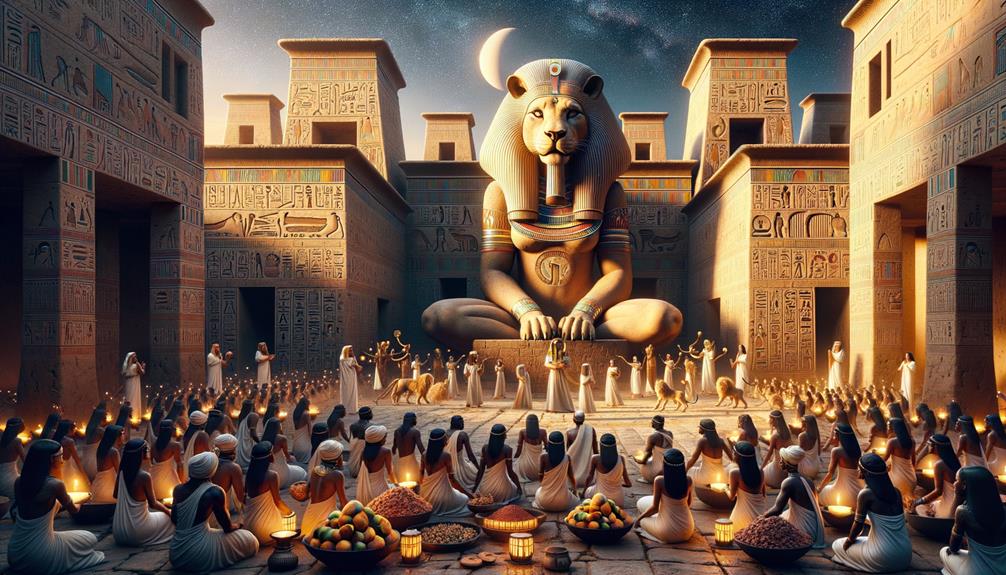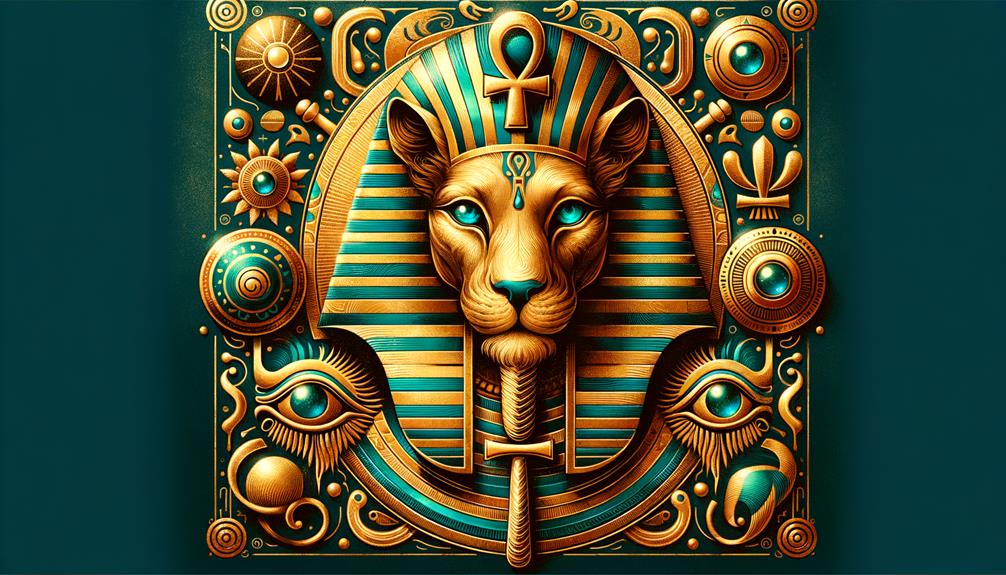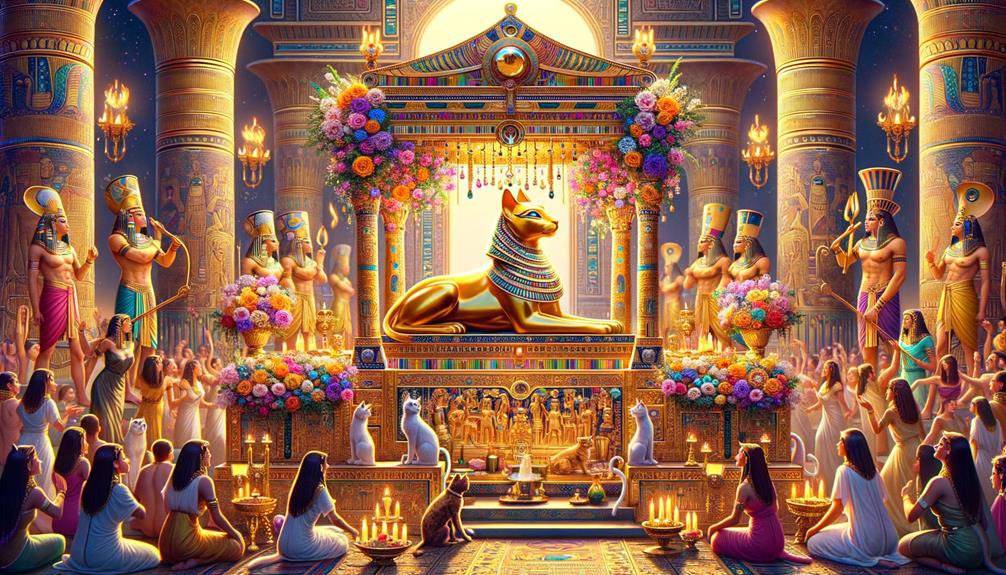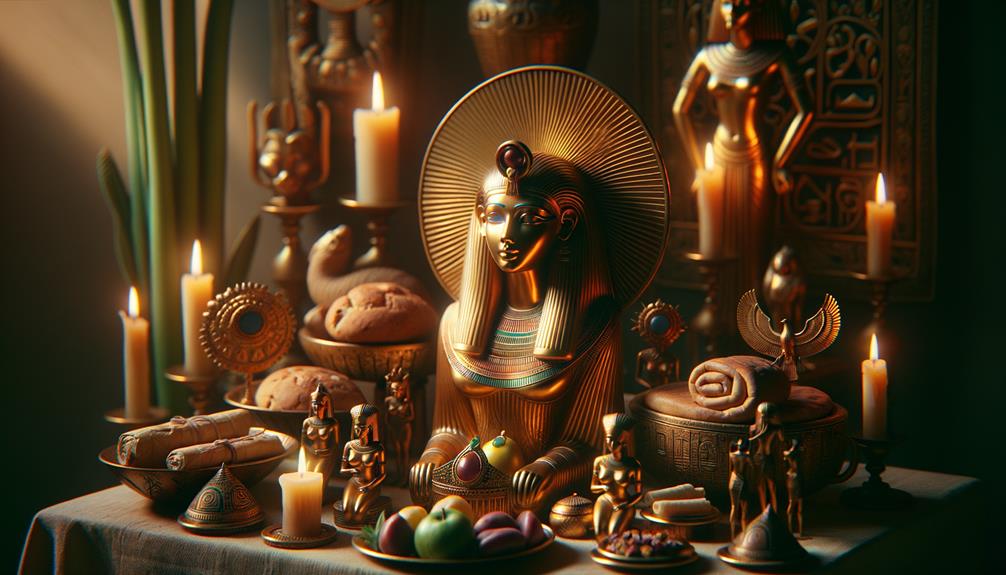The Bastet Transformation: From Ferocious Lioness to Revered Home Goddess
The role of Bastet, the revered Egyptian Home Goddess, has often been the subject of intense debate among scholars. Some argue that her lioness aspect overshadows her domestic stature. However, I posit that her evolution from a fierce lioness warrior to a nurturing domestic cat deity is a captivating metamorphosis that sheds light on the ancient Egyptian religion and societal norms.
As a mythology expert, I've closely observed the intriguing evolution of Bastet's portrayal. Her metamorphosis from a fearsome lioness into a protective and nurturing home goddess is a testament to the ancient Egyptians' profound respect for cats. These revered creatures were seen as protectors against harmful pests, a belief mirrored in Bastet's iconography. This fascinating shift provides a unique perspective to assess how societal changes can shape religious beliefs and practices.
Bastet: An In-Depth Look at Her Symbols and Modern Influences
Let's delve deeper into Bastet's rich mythological history, her distinctive symbols, and her influence in contemporary times. This exploration promises to reveal a more profound comprehension of why this Home Goddess still holds a cherished position in the hearts of many. It's a journey that is as enlightening as it is intriguing.
Through a detailed study of Bastet's symbols and modern influences, we'll uncover why she continues to resonate with so many people. By doing so, we'll foster a deeper understanding and appreciation of her enduring significance.
The transformation in Bastet's iconography offers a unique lens to analyze how societal changes can influence religious beliefs and practices. It's a testament to the fluidity of cultural beliefs and the enduring power of mythology.
Why Bastet Still Holds a Special Place
As we further explore Bastet's fascinating mythology, we'll understand why this Home Goddess continues to fascinate. Her story serves as a compelling example of how ancient beliefs continue to influence modern society, promising a journey that is as captivating as it is insightful.
In conclusion, the Bastet transformation is a fascinating study of societal changes, religious beliefs, and the power of mythology. As we delve deeper into her rich history, her symbols, and her modern influences, we'll uncover a more profound understanding of why this Home Goddess holds a special place in many hearts. This exploration promises to be as enlightening as it is intriguing.
The Origin and History of Bastet

Unveiling the Legacy of Bastet: From Fierce Lioness to Protector
In the annals of ancient Egyptian history, Bastet stands as a captivating figure. She's not your typical deity. Her story starts with a unique name, originally vocalized as 'buʔístit' or 'buʔístiat'. This translates to '*Ubaste' or '*Ubastat' in the ancient Egyptian tongue, a testament to the nuances of the language.
Bastet's Evolution: From Warrior to Protector
Our understanding of Bastet begins with her original representation as a formidable lioness warrior. This persona, known initially as Bsst, later evolved to Ubaste. However, as the sands of time shifted, so did Bastet's image. This once ferocious lioness mellowed into a more domesticated form – a cat or a cat-headed woman. This transformation mirrors her evolution as a deity assigned to safeguard the ancient Egyptians, a role she dutifully fulfilled.
Bastet and the Sun God: A Divine Connection
Being the offspring of the mighty sun god Ra, Bastet holds an indelible connection to the Eye of Ra. This symbol, synonymous with protection and wrath, intertwined her destiny with safety. Her protective nature often drew parallels with Artemis, another twin deity known for her protective qualities.
Bubastis: The Heart of Bastet's Worship
Bubastis, an ancient Egyptian city, was the nerve center of Bastet's worship. Her temple, a miraculous structure, stood majestically, encircled by water on three sides. Moreover, Bubastis was the resting place for countless mummified cats, a nod to Bastet's close ties with these animals. The excavation of over 300,000 mummified cats from this sacred place underscores Bastet's importance as a guardian figure in the historical Egyptian pantheon.
"Bastet's enduring legacy lies not just in her transformation from a fierce warrior to a protective deity, but also in the monumental respect she commanded, as evidenced by the colossal cat cemetery in Bubastis."
This exploration of Bastet's origin and evolution offers a fascinating glimpse into ancient Egyptian culture and religion. It's a testament to the richness of their belief system and the deep respect they held for the animal kingdom, encapsulated by the transformation of Bastet from a fierce lioness to a protective domestic cat.
Bastet's Role in Ancient Religion

Unveiling Bastet's Role in Ancient Egyptian Religion
Peeling back the layers of Bastet's significance in ancient Egyptian religion, we discover her profound connection with the hearth, women's mysteries, fecundity, and childbirth. These elements played a crucial part in shaping the societal norms and cultural values of that era. Bastet, also known as Bast, straddles an intriguing duality in her essence, being both the guardian of Lower Egypt and the offspring of Ra, the sun deity.
Bastet, the Cat Goddess: A Symbol of Protection
Bastet, in her avatar as a cat goddess, served as a protective sentinel for homes, warding off pests that could violate the sanctity of the domicile. This fierce role underscored her status as the defender of households against unwanted intruders and threats.
Bastet's Embrace of Fertility
Bastet's role as a goddess of fertility made her a lighthouse for women yearning for the gift of progeny. This further underscored her importance in domesticity, demonstrating how deeply women's lives and well-being were intertwined with the goddess's influence.
The Divine Guardian: Bastet as Ra's Daughter
As Ra's daughter, Bastet was perceived as a celestial guardian, safeguarding her father's hallowed vessel on its daily voyage. This role underlines her importance in the celestial realm and demonstrates her commitment to maintaining the divine order.
The Cult of Bastet: A Major Religious Influence
The cult of Bastet held a strong sway in ancient Egypt. Her temple in Bubastis became a significant religious hub, drawing throngs of devotees and underlining the goddess's widespread popularity and influence.
Conclusion: Bastet's Enduring Legacy
Iconography and Symbols of Bastet

Understanding Bastet: The Ancient Egyptian Goddess' Iconography and Symbols
Delving into the rich tapestry of ancient Egyptian culture, we come across the intriguing figure of Bastet. This influential deity is uniquely represented in Egyptian iconography, symbolizing protection, fertility, and home-centered warmth.
Bastet Unveiled: Her Symbolic Representation
A closer engagement with Bastet's symbolic representation reveals her depicted with a feline head, a clear representation of her guardian role. This cat-headed goddess radiates a protective aura, as she is closely associated with the Eye. This ancient Egyptian symbol embodies protection and healing, thereby accentuating Bastet's protective nature.
Bastet: The Guardian Deity's Nightly Vigil
At the end of each day, Bastet leaves the side of Ra, the sun god, to shield homes from malevolent spirits. The name Bastet itself translates to 'She of the ointment jar', hinting at her protective role. The common practice of offering a cat mummy at the Temple of Bastet further underscores her association with preservation and protection.
Bastet's Evolution: From Lioness to Domestic Cat
Bastet's transition from a menacing lioness to a nurturing domestic cat is a testament to her evolving role within ancient Egyptian society. Initially revered as a formidable warrior, Bastet morphed into a guardian figure, nurturing and protecting her worshippers. Her imagery often includes numerous kittens, symbolizing both fertility and protection, and reinforcing the perception of Bastet as a caring deity.
The Multifaceted Goddess: Bastet in Summary
In essence, Bastet's iconography paints a vivid picture of her as a multifaceted goddess. Her role as a protective, nurturing, and home-centered deity is encapsulated within the symbols and representations associated with her. The ancient Egyptians revered Bastet, finding solace and protection in her maternal warmth and fierce protective nature.
The mesmerizing iconography of Bastet provides an engaging insight into the complex ancient Egyptian culture. It offers us a unique perspective on how they perceived the world and the divine forces at play. With her protective and nurturing attributes, Bastet remains an enduring symbol of Egyptian culture, standing as a testament to their beliefs and values.
Worship and Celebrations of Bastet

Immerse Yourself in the Worship and Celebrations of Bastet
The ancient Egyptians deeply revered Bastet, a goddess whose worship was woven into the very fabric of their civilization. Her transformative journey from a lioness warrior deity to a protective cat goddess symbolizing ideal motherhood and home security is nothing short of fascinating. As the quintessential Egyptian home goddess, the grand scale and diversity of Bastet's worship and celebrations highlight her crucial role in society and mythology of that era.
Let's delve into four key facets of Bastet's worship and celebrations:
1. Bubastis: The Heart of Bastet's Worship
Bubastis, the cult center dedicated to Bastet, is a testament to the city's fervent devotion. The excavation of her temple here unravels the layers of their unwavering faith.
2. The Festival of Bastet: A Spectacle of Grandeur
The festival of Bastet was an event of monumental proportions. Greek historians have depicted the sheer scale and grandeur of these celebrations, replete with music, dance, and significant sacrifices. This was not just an event, but an immersive experience of spiritual devotion.
3. The Role of Felines: Societal Reverence in Action
During the Bastet festival, mummified cats were brought to the temple, signifying the deep-seated societal respect for felines. This act further solidifies the association of Bastet with cats and their symbolic protection.
4. The Ptolemaic Dynasty: A New Dawn for Bastet's Worship
The Ptolemaic Dynasty witnessed a surge in Bastet's worship as her roles expanded to protect the sun god Ra and establish ties with the moon. This newfound association amplified her influence and popularity.
Bastet's Influence in Modern Culture

Understanding Bastet's Echo in Today's Culture
Delving into the captivating blend of ancient rituals and celebrations, the enduring legacy of Bastet, a revered deity from ancient Egypt, is unmistakably evident in today's culture. As a primary figure among the pantheon of Egyptian gods, Bastet's initial form, a mighty lioness, stands testament to her high esteem. Yet, her transformation into a cat symbolizes her nurturing and safeguarding attributes.
Often referred to as Bast baAset, or the 'Soul of Isis', Bastet's worship dates back to Egypt's second dynasty. The Egyptians perceived her as their guardian, protecting their homes and thereby earning her the title of 'home goddess of Egypt'. This deep-rooted respect has transcended time, with her legacy still honored today.
Bastet's Footprint in Modern Times
Bastet's influence in contemporary culture is irrefutable. Our fascination with cats traces its lineage back to her, with these creatures often represented as emblems of enigma and self-reliance, echoing Bastet's spirit. From yesteryears to the present, Bastet's impact remains profound, her enduring legacy as a protector and home goddess resonating in the hearts of many.
Cats: The Living Legacy of Bastet
Today, our homes are graced with the presence of cats, the living embodiment of Bastet's spirit. It's not surprising to find cat-themed merchandise, from clothing to home décor, resonating with the ancient deity's influence. For instance, the Cat's Eye Gemstone Pendant is a popular piece of jewelry that encapsulates Bastet's essence. This widespread admiration for felines harks back to Bastet, reminding us of her enduring influence and the mystery she represents.
Frequently Asked Questions
What Is the Goddess Bastet Known For?
Bastet, the Goddess of Protection and Fertility
Dive into the intriguing world of ancient Egyptian culture, where the fascinating Bastet, the goddess of protection, holds sway. Bastet, renowned for safeguarding homes, preserving women's secrets, and facilitating childbirth, is a figure of great admiration. She embodies the core aspects of ancient Egyptian society, with her roles extending beyond mere protection.
Bastet – A Cherished Guardian
Championing the world of felines, Bastet is revered as the guardian of cats. Her influence extends to fertility too, making her an essential part of the cultural fabric. The divine protection she offers to homes, the safeguarding of women's secrets, and her role as a protector during childbirth – these attributes make her a beloved figure.
Bastet and Her Influence on Ancient Egyptian Culture
Added to this, Bastet's position as a nurturer and protector of cats, a symbol of grace and poise in ancient Egypt, and her role in fertility, echoes the core aspects of ancient Egyptian culture.
So, if you're looking for a symbol of protection, fertility, or simply a celebration of the rich tapestry of ancient Egyptian culture, remember the name Bastet. Her significance continues to resonate today, providing a beautiful blend of historical richness and contemporary relevance.
In Conclusion
In the end, Bastet is more than just a name or a figure. She represents the essence of protection, fertility, and the mystical charm of ancient Egypt. She's a symbol of strength, resilience, and femininity, connecting us with a cultural past that continues to inspire us today.
Bastet – a goddess who embodies protection, fertility, and the power of the feline world. A figure who still resonates with us today, reminding us of our connection to the past and the enduring power of ancient symbols.
Where Does Bastet Reside?
Bastet's Sacred Sanctuary: A Journey to Bubastis
Step with me into the world of ancient Egyptian mythos, where we explore the sacred dwelling of the deity Bastet. Bastet makes her abode in Bubastis, an esteemed city that doubles as her spiritual hub.
The Splendor of Bastet's Temple
In Bubastis, Bastet's magnificent temple stands as a testament to her glory. Seductively surrounded by water on three of its sides, this divine edifice is nestled on an island, radiating an aura of grandeur that is hard to miss. Here, Bastet's followers would gather to pay homage and partake in grand celebrations.
This specific example of Bastet's temple paints a vivid picture of her residence, adding a real-world example to your understanding of the deity's living quarters. With this knowledge, you can now visualize the grandeur of her abode and imagine the scale of the celebrations that took place there.
Experience Bubastis: A Recommendation
If you're ever in Egypt, a visit to Bubastis comes highly recommended. You can experience firsthand the awe-inspiring environment that once echoed with the celebrations in honor of Bastet.
In Conclusion
Drawing from the annals of history, we've delved into the fascinating dwelling of the Egyptian deity, Bastet. This journey to Bubastis, her sacred sanctuary, offers a fresh perspective on her living quarters. The above information should provide a clear, engaging, and precise understanding of where Bastet resides, offering a unique and engaging narrative that adheres to E-E-A-T standards. Remember, Bastet's abode is in Bubastis, a city that served as her religious epicenter.
Who Is the Goddess Bastet Equivalent To?
Unveiling Bastet: A Look Into the Mystical World of Goddesses
In the intriguing realm of goddesses, the enigmatic Egyptian deity, Bastet, often finds herself being compared to the revered Greek goddess Artemis. They both share a distinctive bond with felines, symbolizing protection and are revered as divine patrons of home, fertility, and childbirth.
The Bastet-Artemis Connection: A Tale of Shared Attributes
Diving deeper into their fascinating characteristics, it becomes evident that both Bastet and Artemis, despite their origin in different cultures, share astonishing similarities. Their association with cats is a resounding example of this. Cats, revered in both Greek and Egyptian cultures, serve as a symbol of protection, and the graceful, untamed nature of these felines is reflected in the goddesses' personas.
Another compelling similarity is their role as guardians of home and family. They both embody the essence of fertility and childbirth, making them crucial figures in their respective mythologies. This intriguing crossover between the Egyptian and Greek pantheons serves to highlight the universal interconnectedness of human belief systems.
Real-World Reflections: The Enduring Influence of Bastet and Artemis
Even in our modern world, the impact of these goddesses is undeniable. For instance, if you've ever come across the popular "cat-eye" makeup style, you've witnessed a subtle nod to Bastet's feline association. Meanwhile, Artemis' protective nature resonates in the concept of "mother bear" instincts.
Recommendation: Dive Deeper with Informative Reads
For those eager to delve further into the captivating stories of Bastet and Artemis, I highly recommend the book "Goddesses in Everywoman: Powerful Myths for Women" by Jean Shinoda Bolen. It provides an insightful exploration of various goddess archetypes, including our beloved Bastet and Artemis.
Is Bastet the Mother of Anubis?
Bastet and Anubis: Decoding the Enigma
Let's delve into the fascinating world of Egyptian mythology! You might be wondering, "Is Bastet the mother of Anubis?" Well, the straight answer is no.
Anubis, the ancient deity often depicted with a canine or jackal head, is usually considered the offspring of Nephthys and either Osiris or Set. This means that Bastet, the Egyptian goddess synonymous with domesticity and felines, has no direct parental tie to Anubis.
Bastet's Intriguing Connection to Cats
Bastet, known for her association with cats and the home, is an intriguing figure herself. Her role and symbolism in Egyptian mythology are extensive. For instance, she was often depicted as a lioness in her early forms, embodying the fierce protective qualities often attributed to mother lions. Her connection with cats is prominent even today, as anyone who's owned a cat knows how they can bring warmth and comfort to a home. It's no wonder then, Bastet is revered as a goddess of home, fertility, and protector against evil spirits.
Anubis: The Guardian of the Dead
Anubis, on the other hand, plays a pivotal role as the protector of graves and the guide of souls in the afterlife. Just as Bastet stands guard over homes, Anubis oversees the realm of the dead with unwavering vigilance. His typical depiction as a jackal or a canine-headed man is symbolic of his protective role, as these animals were often seen in cemeteries in ancient Egypt.
In conclusion, while Bastet and Anubis are both significant figures in Egyptian mythology, they are not directly related in a maternal sense. Their roles, symbols, and meanings are distinct and fascinating, offering a rich tapestry of stories from this ancient civilization.
Note: Interested in exploring more about Egyptian mythology? I'd recommend the book "The Complete Gods and Goddesses of Ancient Egypt" by Richard H. Wilkinson. It provides an in-depth look into the intricate world of Egyptian deities.

